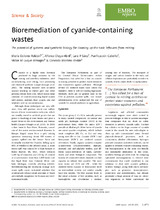Mostrar el registro sencillo del ítem
Bioremediation of cyanide-containing wastes: The potential of systems and synthetic biology for cleaning up the toxic leftovers from mining
| dc.contributor.author | Roldán Alfonso, María Dolores | |
| dc.contributor.author | Olaya-Abril, Alfonso | |
| dc.contributor.author | Sáez, Lara P. | |
| dc.contributor.author | Cabello, Purificación | |
| dc.contributor.author | Luque-Almagro, Víctor Manuel | |
| dc.contributor.author | Moreno-Vivián, Conrado | |
| dc.date.accessioned | 2021-10-22T07:25:37Z | |
| dc.date.available | 2021-10-22T07:25:37Z | |
| dc.date.issued | 2021 | |
| dc.identifier.uri | http://hdl.handle.net/10396/21932 | |
| dc.description.abstract | Cyanide is a highly toxic chemical produced in large amounts by the mining and jewellery industries, steel manufacturing, coal coking, food processing and chemical synthesis (Luque-Almagro et al, 2011). The mining industry uses so-called cyanide leaching to extract gold and other precious metals from ores, which leaves large amounts of cyanide-containing liquid wastes with arsenic, mercury, lead, copper, zinc and sulphuric acid as cocontaminants. Although these techniques are very efficient, they still produce about one million tonnes of toxic wastewaters each year, which are usually stored in artificial ponds that are prone to leaching or dam breaks and pose a major threat to the environment and human health (Luque-Almagro et al, 2016). In 2000, a dam burst in Baia Mare, Romania, caused one of the worst environmental disasters in Europe. Liquid waste from a gold mining operation containing about 100 tonnes of cyanide spilled into the Somes River and eventually reached the Danube, killing up to 80% of wildlife in the affected areas. A more recent spill was caused by a blast furnace at Burns Harbor, IN, USA, which released 2,400 kg of ammonia and 260 kg of cyanide at concentrations more than 1,000 times over the legal limit into Calumet River and Lake Michigan, severely affecting wildlife. Notwithstanding the enormous damage such major spills cause, industrial activities that continuously release small amounts of waste are similarly dangerous for human and environmental health. The European Parliament, as part of its General Union Environment Action Programme, has called for a ban on cyanide in mining activities to protect water resources and ecosystems against pollution. Although several EU member states have joined this initiative, there is still no binding legislation. Similarly, there are no general laws in the USA to prevent cyanide spills, and former administration even authorized the use of cyanide for control predators in agriculture. | |
| dc.format.mimetype | application/pdf | es_ES |
| dc.language.iso | eng | es_ES |
| dc.publisher | Wiley | es_ES |
| dc.rights | https://creativecommons.org/licenses/by-nc-nd/4.0/ | es_ES |
| dc.source | EMBO Reports, e53720 (2021) | es_ES |
| dc.subject | Cyanides | es_ES |
| dc.subject | Microbial degradation | es_ES |
| dc.subject | Cyanomics | es_ES |
| dc.subject | Biodegradative process | es_ES |
| dc.subject | Bioremediation | es_ES |
| dc.title | Bioremediation of cyanide-containing wastes: The potential of systems and synthetic biology for cleaning up the toxic leftovers from mining | es_ES |
| dc.type | info:eu-repo/semantics/article | es_ES |
| dc.relation.publisherversion | https://doi.org/10.15252/embr.202153720 | es_ES |
| dc.relation.projectID | Gobierno de España. RTI2018-099573-B-100 | es_ES |
| dc.relation.projectID | Junta de Andalucía. P18-RT-3048 | es_ES |
| dc.rights.accessRights | info:eu-repo/semantics/openAccess | es_ES |

